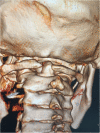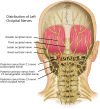Suboccipital neuralgia after C1 pedicle screw insertion: do we neglect atlantooccipital joint violation? - Case report and literature review
- PMID: 31337382
- PMCID: PMC6652010
- DOI: 10.1186/s12893-019-0551-3
Suboccipital neuralgia after C1 pedicle screw insertion: do we neglect atlantooccipital joint violation? - Case report and literature review
Abstract
Background: Occipital neuralgia is one of the postoperative complications of C1 lateral mass screw insertion, which was deemed to be related with the C2 nerve root dysfunction.
Case presentation: A 52-year-old female patient presented with gradually progressive numbness and weakness in her extremities for 6 months. X-ray and computed tomography (CT) scan revealed obvious anterior atlantoaxial dislocation (ADD), which was reducible on extensive view. Atlantoaxial pedicle screw fixation and bone graft was performed. Immediately after the operation, the neurological symptom significantly improved. The patient complained of restricted cervical rotation and suboccipital neuralgia which was exacerbated by rotation with an intensity of 7 on a visual analog scale (VAS) ranging from 0 to 10 at postoperative day 5. While a satisfactory reduction was detected in the postoperative CT, violation of the left atlantooccipital joint was observed in the left C1 screw. Nimesulide (daily dosage of 0.2 g) and bracing were recommended immediately. At the 2 month follow-up, both the neurological improvement and reduction were maintained. The VAS of suboccipital neuralgia is 3 and decreased to 1 at 6 months postoperative. Bony fusion of the left atlantooccipital joint was confirmed by CT scan at 6 months postoperative. The patient complained that the suboccipital neuralgia was tolerable without the assistance of braces or medications for pain. At the 18 month follow-up, only stiffness of head flexion and rotation was observed without suboccipital neuralgia.
Conclusion: Suboccipital neuralgia after atlantooccipital joint violation of C1 pedicle screw placement most likely results from C1 nerve root irritation. As the corresponding dermatome differs from the distributing region and aggravated factor of C2 nerve root dysfunction, neuralgia due to C1 irritation was only localized at suboccipital region and exacerbated by rotation.
Keywords: Atlantoaxial fixation; Atlantoaxial instability; Atlas screw; Complications; Lateral mass; Occipital neuralgia; Pedicle.
Conflict of interest statement
The authors declare that they have no competing interests.
Figures






Similar articles
-
Postoperative occipital neuralgia with and without C2 nerve root transection during atlantoaxial screw fixation: a post-hoc comparative outcome study of prospectively collected data.Spine J. 2013 Jul;13(7):786-95. doi: 10.1016/j.spinee.2013.04.006. Epub 2013 May 24. Spine J. 2013. PMID: 23711959
-
C1 Titanium Cables Combined with C2 Pedicle Screw-Rod Fixation for Atlantoaxial Instability Not Suitable for Placement of C1 Screws.World Neurosurg. 2018 Dec;120:e453-e456. doi: 10.1016/j.wneu.2018.08.103. Epub 2018 Aug 24. World Neurosurg. 2018. PMID: 30149165
-
[Harms technique of C1-C2 fixation with polyaxial screws and rods].Acta Chir Orthop Traumatol Cech. 2005;72(1):22-7. Acta Chir Orthop Traumatol Cech. 2005. PMID: 15860148 Czech.
-
Occipital bone erosion induced by C1 pedicle screw as a late complication of atlantoaxial fixation: a case report and literature review.Spine Deform. 2021 Mar;9(2):621-625. doi: 10.1007/s43390-020-00222-1. Epub 2020 Oct 8. Spine Deform. 2021. PMID: 33030699 Review.
-
C2 nerve dysfunction associated with C1 lateral mass screw fixation.Orthop Surg. 2014 Nov;6(4):269-73. doi: 10.1111/os.12136. Orthop Surg. 2014. PMID: 25430709 Free PMC article. Review.
References
-
- Resnick DK, Benzel EC. C1–C2 pedicle screw fixation with rigid cantilever beam construct: case report and technical note. Neurosurgery. 2002;50:426–428. - PubMed
Publication types
MeSH terms
Grants and funding
LinkOut - more resources
Full Text Sources
Medical
Research Materials
Miscellaneous

